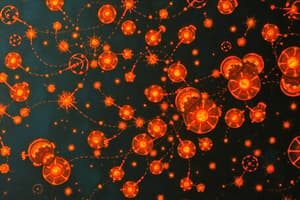Podcast
Questions and Answers
What are the types of extracellular signals according to the distance the signalling molecule (ligand) travels?
What are the types of extracellular signals according to the distance the signalling molecule (ligand) travels?
- Hormonal, paracrine, autocrine, juxtacrine
- Neuroendocrine, paracrine, autocrine, juxtacrine
- Endocrine, paracrine, autocrine, juxtacrine (correct)
- Neurotransmission, paracrine, autocrine, juxtacrine
Which type of ligands cannot cross the plasma membrane and bind to cell surface receptors?
Which type of ligands cannot cross the plasma membrane and bind to cell surface receptors?
- Neurotransmitter ligands
- Hydrophilic ligands (peptides, proteins, amphiphile lipids) (correct)
- Hormonal ligands
- Hydrophobic ligands (lipids, thyroid hormones)
Which component of signal transduction directly binds to the intracellular receptors for hydrophobic ligands?
Which component of signal transduction directly binds to the intracellular receptors for hydrophobic ligands?
- Steroid receptor (correct)
- Pol II
- p23
- Hsp90
How may the biological response of a cell emerge through signal transduction?
How may the biological response of a cell emerge through signal transduction?
Which molecules are considered as second messengers in signal transduction pathways?
Which molecules are considered as second messengers in signal transduction pathways?
What is the function of Hsp90 and p23 in the context of signal transduction?
What is the function of Hsp90 and p23 in the context of signal transduction?
Which type of ligands bind to cell surface receptors and cannot cross the plasma membrane?
Which type of ligands bind to cell surface receptors and cannot cross the plasma membrane?
What are the possible ways in which the biological response of a cell may emerge through signal transduction?
What are the possible ways in which the biological response of a cell may emerge through signal transduction?
Which component of signal transduction is responsible for converting information to chemical processes within the cell?
Which component of signal transduction is responsible for converting information to chemical processes within the cell?
What is the main function of nuclear receptors in signal transduction pathways?
What is the main function of nuclear receptors in signal transduction pathways?
Which process involves the alteration of the set of proteins by the regulation of gene expression?
Which process involves the alteration of the set of proteins by the regulation of gene expression?
What is responsible for binding hydrophobic ligands and crossing the plasma membrane to bind to intracellular receptors?
What is responsible for binding hydrophobic ligands and crossing the plasma membrane to bind to intracellular receptors?
Which type of ligands are unable to cross the plasma membrane and bind to cell surface receptors?
Which type of ligands are unable to cross the plasma membrane and bind to cell surface receptors?
What type of signals involve the travel of the signaling molecule (ligand) over a short distance to act locally?
What type of signals involve the travel of the signaling molecule (ligand) over a short distance to act locally?
Which component of signal transduction is responsible for converting information to chemical processes within the cell?
Which component of signal transduction is responsible for converting information to chemical processes within the cell?
Study Notes
Types of Extracellular Signals
- Extracellular signals can be categorized based on the distance the signaling molecule (ligand) travels, including:
- Autocrine signals: act on the same cell that produced the ligand
- Paracrine signals: act on neighboring cells
- Endocrine signals: act on distant cells or tissues
- Juxtacrine signals: act on adjacent cells, with the ligand remaining attached to the cell surface
Ligands and Receptors
- Hydrophilic ligands cannot cross the plasma membrane and bind to cell surface receptors
- Lipophilic ligands can cross the plasma membrane and bind to intracellular receptors
- Heat shock protein 90 (Hsp90) and p23 are components of signal transduction that directly bind to intracellular receptors for hydrophobic ligands
Signal Transduction Pathways
- Biological response of a cell emerges through signal transduction by:
- Activating or inhibiting enzymes
- Opening or closing ion channels
- Altering gene expression
- Changing the activity of transcription factors
- Second messengers in signal transduction pathways include:
- Cyclic AMP (cAMP)
- Cyclic GMP (cGMP)
- Inositol trisphosphate (IP3)
- Diacylglycerol (DAG)
- Calcium ions (Ca2+)
Regulation of Gene Expression
- The process of altering the set of proteins by regulating gene expression is called epigenetic regulation
- Nuclear receptors, as a component of signal transduction, are responsible for binding to DNA and regulating gene expression in response to hydrophobic ligands
Conversion of Information
- The component of signal transduction responsible for converting information to chemical processes within the cell is the signal transduction cascade
Studying That Suits You
Use AI to generate personalized quizzes and flashcards to suit your learning preferences.
Description
Test your knowledge in cell biology, signal transduction, and extracellular matrix with this quiz. The quiz covers topics such as cell adhesion structures, molecular and cellular biology, and the extracellular matrix.




